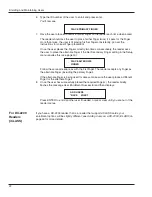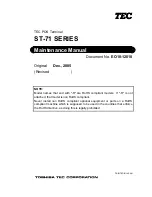
HandKey II Manual
13
Networking Readers
If readers are connected by RS-485, you can connect up to 32 readers to each other.
This allows one reader to serve as a master; it can get users from other readers and send
new users back to them; this lets you enroll a user on one reader and then give that user
access at all of them. See
Getting Users from Other Readers
starting on page 43.
Unless you have the appropriate networking knowledge, we don’t recommend trying to
set up a reader network on your own. We train our dealers to set up reader networks
correctly; we recommend using their services if you are networking readers.
If you network a group of readers to each other and they are not managed by some
software, then you must designate one of the readers as a master, and the rest must be
set up as remote readers; that is, they can’t be designated as master readers.
If your readers are managed by some computer software, the software is the master, so
no readers would be designated as a master
See
Indicating Whether the Reader is a Master
on page 38 for help changing this setting.
Make sure that DIP switch 1 is set to reflect the type of wiring you use; see
Controlling
how readers are networked
on page 10.
To create a RS-485 network, use a single twisted pair of wires (plus a ground). For each
reader, connect pin 10 (Tx +/-) on the terminal block to pin 10 on the next reader, connect
pin 11 (ground) to pin 11, and connect pin 12 (Rx +/-) to pin 12. You can connect up to 32
readers. You must use a daisy-chain; a star configuration will NOT work correctly.
For a RS-485 network, at 9600 baud, the maximum total line length for the network is
4000 feet. Use Belden cable 82723 or the equivalent (minimum 22 gage).
For a RS-232 network (which can only connect a single reader to a host computer), the
maximum line length is 50 feet.
Networking
Caution
Designating a
Master Reader
Making Sure
DIP Switches
are Set UP
Correctly
Network Wiring
















































